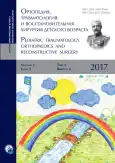Feet injuries in children with tarsal coalitions
- Authors: Sapogovskiy A.V.1
-
Affiliations:
- The Turner Scientific and Research Institute for Children’s Orthopedics
- Issue: Vol 5, No 2 (2017)
- Pages: 22-25
- Section: Articles
- URL: https://ogarev-online.ru/turner/article/view/6752
- DOI: https://doi.org/10.17816/PTORS5222-25
- ID: 6752
Cite item
Abstract
Introduction. Tarsal coalition is a foot bone malformation, characterized by bony, cartilaginous or fibrosis fusion between the tarsal bones. It clinically appears as decreased mobility of the tarsal joints. This feature can be predicting factor for feet injuries.
Aim: This study analyzed the frequency and nature of the injuries of the feet in patients with tarsal coalitions.
Materials and methods. TThe article presents data on the frequency and nature of feet injuries in patients with tarsal coalitions (22 patients (30 feet) with talocalcaneal coalitions and 28 patients (45 feet) with calcaneonavicular coalitions) aged 12 to 18 years. The control group included 50 patients (80 feet) with flatfeet without tarsal coalitions, aged 12 to 15 years. The study was a retrospective analysis of anamnestic data of feet injuries.
Results. The study found patients with tarsal coalitions had a significantly higher incidence of ankle sprains (the general group – 26 patients (52%) versus the control group – 12 (24%).
Conclusion. Tarsal coalition can be predicting factor to feet injuries. Patients with tarsal coalitions should consider this concern for sports activities. They can use different orthoses, tape, or choose not to engage in traumatic sports to avoid ankle sprains.
Keywords
Full Text
##article.viewOnOriginalSite##About the authors
Andrei V. Sapogovskiy
The Turner Scientific and Research Institute for Children’s Orthopedics
Author for correspondence.
Email: sapogovskiy@gmail.com
MD, PhD research associate of the department of foot pathology, neuroorthopedics and systemic diseases.
Russian Federation, Saint PetersburgReferences
- Кенис В.М. Тарзальные коалиции у детей: опыт диагностики и лечения // Травматология и ортопедия России. – 2011. – № 2. – С. 132–136. [Kenis VM. Tarsal coalitions in children: diagnostics and treatment. Traumatology and Orthopedics of Russia. 2011;(2):132-136. (In Russ.)]. doi: 10.21823/2311-2905-2011-0-2-132-136.
- Кенис В.М., Никитина Н.В. Тарзальные коалиции у детей (обзор литературы) // Травматология и ортопедия России. – 2010. – № 3. – С. 159–165. [Kenis VM, Nikitina NV. Tarsal coalitions in children (review). Traumatology and Orthopedics of Russia. 2010;(3):159-165. (In Russ.)]. doi: 10.21823/2311-2905-2010-0-3-159-165.
- Сапоговский А.В., Кенис В.М. Клиническая диагностика ригидных форм плано-вальгусных деформаций стоп у детей // Травматология и ортопедия России. – 2015. – № 4. – С. 46–51. [Sapogovsky AV, Kenis VM. Clinical diagnosis of rigid flatfооt in children. Traumatology and Orthopedics of Russia. 2015;(4):46-51. (In Russ.)]. doi: 10.21823/2311-2905-2015-0-4-46-51.
- Kendrick JI. Tarsal coalitions. Clin Orthop. 1972;85:62-63. doi: 10.1097/00003086-197206000-00013.
- Snyder RB, Lipscomb AB, Johnston RK. The relationship of tarsal coalitions to ankle sprains in athletes. Am J Sports Med. 1981;9(5):313-317. doi: 10.1177/036354658100900505.
- Levy JC, Mizel MS, Wilson LS, et al. Incidence of foot and ankle injuries in West Point cadets with pes planus compared to the general cadet population. Foot Ankle Int. 2006;27(12):1060-4. doi: 10.1177/107110070602701211.
Supplementary files







